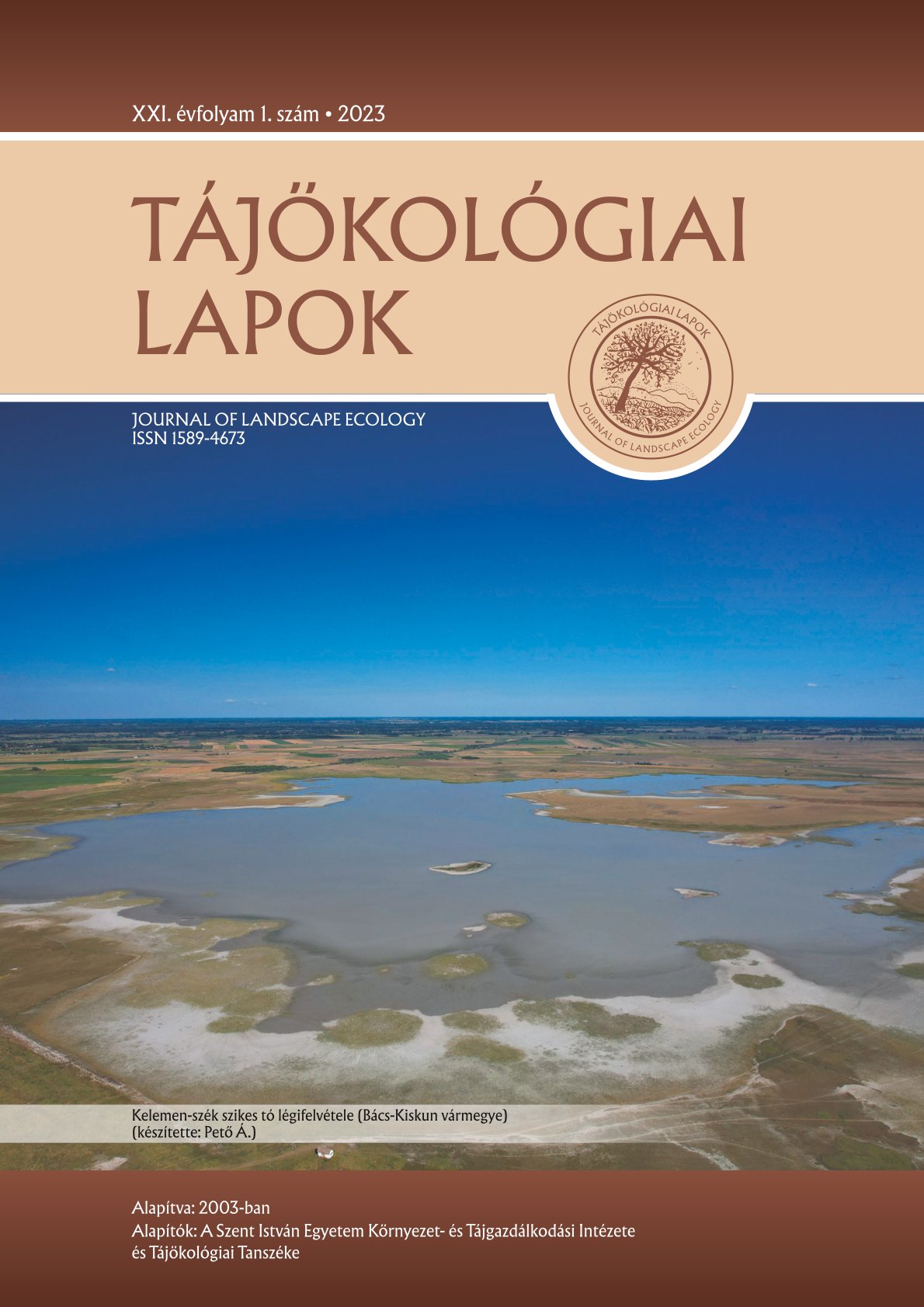The determination process of nature conservation values, its past, present and future
DOI:
https://doi.org/10.56617/tl.4886Keywords:
protection, vulnerability, nature conservation service, Red Books, cost categoriesAbstract
Many factors are influencing the extinction of species. Besides the competition between the species and natural selection, more significant factors can be mentioned, like adverse effects of people’s activity, increasing environmental pollution, the destruction of habitats, tourism, and the people’s collection passion, which all contribute to the loss of biodiversity. It is impossible to choose a species and exchange that for money because their role in the biological cycle does not allow this. However, it is still necessary to endow them with nature conservation values. As a result of this investigation, it has been turned out that there is no available elaborated uniform methodology determining the goodwill value of species neither in Hungary nor in the European Union. These values have been determined based on expert reports. The nature conversation values of some species can be found in the Annexes of the Hungarian Regulation 13/2001. (V. 9.) KöM, which is currently in force in Hungary. The nearly 2100 species have been classified into cost categories based on the aspects like the evolution of the number of individuals, the global or local rarity, the level of to be endangered, the condition of habitats, the recognisability, and attractiveness. The actuality of the topic is given, as the legislation has been revised three times in the last four decades (12/1993. (III. 31.) KTM decree, 13/2001. (V. 9.) KöM decree, 100/2012. (IX. 28.) VM decree) and the next broad revision of the Regulation is expected to be in the near future. The task of the Nature Conservation Services of the National Parks is preservation the protected species of plants, animals, and mushrooms and to save them from damage, but the lack of capacity within the services (approximately 250 persons to the whole area of Hungary) makes it challenging to check and to measure on-site.
References
Bartha D. 2000: Vörös Lista. Magyarország veszélyeztetett fa- és cserjefajai. Kék lista. Magyarország aktív védelemben részesülő fa- és cserjefajai. Fekete Lista. Magyarország adventív fa- és cserjefajai. Magánkiadás, Sopron. p. 32
Bartha D. 2019: Vörös Lista. Magyarország veszélyeztetett fa- és cserjefajai. Soproni Egyetem Kiadó, Sopron, p. 59
Bartha D. 2020: Fekete Lista. Magyarország inváziós fa- és cserjefajai. Szürke Lista. Magyarország potenciálisan inváziós fa- és cserjefajai. Soproni Egyetem Kiadó, Sopron, p. 84
Bartha D. 2020: Figyelmeztet a Vörös Lista. Természetbúvár 75(1): 16–18.
Bartha D., Király G., Schmidt D., Tiborcz V., Barina Z., Csiky J., Jakab G., Lesku B., Schmotzer A.R., Vojtkó A., Zólyomi Sz. (szerk.) 2015: Atlasz Flóra Hungariae, Magyarország edényes növényfajainak elterjedési atlasza. — Nyugat-Magyarországi Egyetem Kiadó, Sopron, p. 329
BirdLife International 2021: European Red List of Birds. Luxembourg: Publications Office of the European Union.
Farkas O. 2013: Az eszmei értékek alakulásának áttekintés Magyarországon 1982 és 2012 között. In: Meyer D., Kósi K., Valkó L., Tóth Zs. E., Hevér B., Horváth Gy. Á. (szerk.): Tehetséggondozás a BME GTK Gazdálkodás- és Szervezéstudományi Doktori Iskolában. Budapesti Műszaki és Gazdaságtudományi Egyetem, pp. 149–163.
Farkas S. 1999: Magyarország védett növényei. Mezőgazda Kiadó, Budapest. p. 416.
Király G. (szerk.) 2007: Vörös Lista. A magyarországi edényes flóra veszélyeztetett fajai. Magánkiadás, Sopron. p. 73.
Korda M. 2021: Aktualizálásra került a hazai dendroflóra Vörös, Fekete és Szürke Listája. Természetvédelmi Közlemények 27: 176–178.
Kovács E. 2017: A nemzeti park igazgatóságok 2000–2015 közötti költségvetésének értékelése az alapfeladataik tükrében. Természetvédelmi Közlemények 23: 201–223.
Marjainé Sz. Zs. (szerk.) 2005: A természetvédelemben alkalmazható közgazdasági eszközök. A Környezetvédelmi és Vízügyi Minisztérium Természetvédelmi Hivatalának Tanulmánykötete. Budapest, p. 155.
Nagy G. 2022: Az Európai Madárfajok Vörös Listája. Természetbúvár 77(2): 6–9.
Rimóczi I., Siller I., Vasas G., Albert L., Vetter J., Bratek Z. 1999: Magyarország nagygombáinak javasolt Vörös Listája. Mikológiai Közlemények – Clusiana 38 (1-3): 107–132.
Tanács E., Bede-Fazekas Á., Csecserits A., Kisné Fodor L., Pásztor L., Somodi I., Standovár T., Zlinszky A., Zsembery Z., Vári Á. 2022: Assessing ecosystem condition at the national level in Hungary - indicators, approaches, challenges. One Ecosystem 7: e81543. DOI: https://doi.org/10.3897/oneeco.7.e81543
Tóth L., Nagy Sz., Haraszthy L. 1999: Vörös Lista. Magyarország fészkelő madarainak védelmi helyzete. Magyar Madártani és Természetvédelmi Egyesület, Budapest.
Hivatkozott jogszabályok és rendeletek
A természet védelméről szóló 1996. évi LIII. törvény
A védett és a fokozottan védett növény- és állatfajokról, a fokozottan védett barlangok köréről, valamint az Európai Közösségben természetvédelmi szempontból jelentős növény-és állatfajok közzétételéről szóló 13/2001. (V. 9.) KöM rendelet
A 28/1994. (V. 20.) Alkotmánybírósági határozat
Internetes források
https://www.termeszetvedelem.hu
https://portals.iucn.org/library/efiles/documents/EPLP-026.pdf
https://www.eea.europa.eu/publications/state-of-nature-in-the-eu-2020
https://www.mme.hu/mindennapi-madaraink-monitoringja-mmm
Downloads
Published
Issue
Section
License
Copyright (c) 2023 Farkas Orsolya, Szalmáné Csete Mária

This work is licensed under a Creative Commons Attribution-NonCommercial-NoDerivatives 4.0 International License.
A folyóirat Open Access (Gold). Cikkeire a Creative Commons 4.0 standard licenc alábbi típusa vonatkozik: CC-BY-NC-ND-4.0. Ennek értelmében a mű szabadon másolható, terjeszthető, bemutatható és előadható, azonban nem használható fel kereskedelmi célokra (NC), továbbá nem módosítható és nem készíthető belőle átdolgozás, származékos mű (ND). A licenc alapján a szerző vagy a jogosult által meghatározott módon fel kell tüntetni a szerző nevét és a szerzői mű címét (BY).












